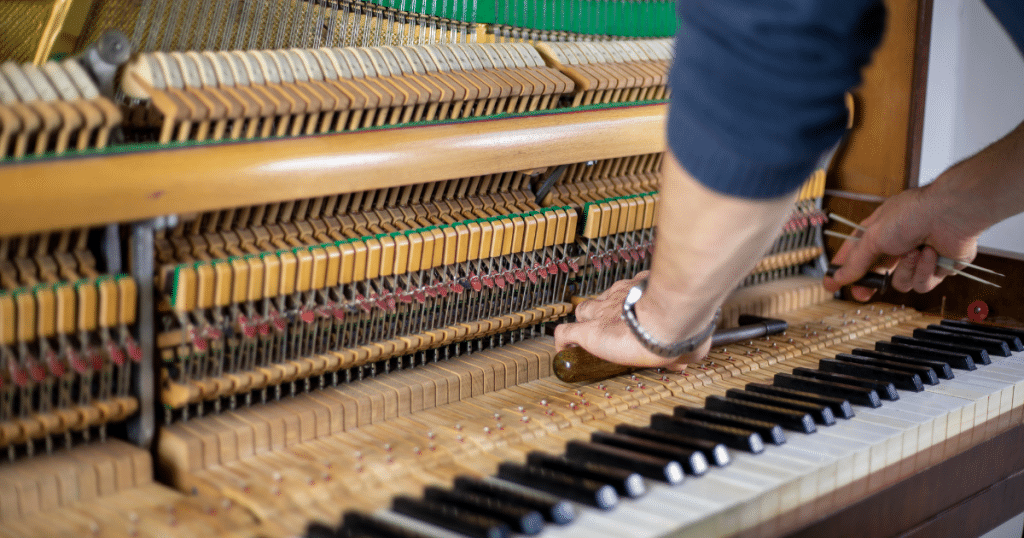Pianos are fragile instruments that should be tuned every year, ideally every two years. The cost could be pretty costly for a tune that costs around $100. If you’re inclined to tune your piano by yourself, note that this task will take much work and energy.
To get the best sound, it requires piano tuning every two years. You may tackle it yourself if you’re a new piano owner or aspiring musician. Learn how to tune your piano.
What’s Piano Tuning?
Piano tuning alters the string tension and changes the pitch or frequency of vibration by turning slightly the tuning pins that they’re connected to and ensuring that every string sounds harmoniously with the other strings. Harmony is achieved by tuning the piano according to specific acoustical laws and the rules of aesthetics and customs.
If you’ve never tuned your piano or aren’t interested in spending years practicing. Consider speaking to professionals like Burton and Walison Piano.
How To Tune A Piano?
Here is a simple step-by-step tutorial for tuning your piano:
1. Setup
Before you start tuning your piano, you should make the space as quiet and secluded as possible. Close the doors and turn off any appliances, particularly those that emit humming noises.
Close any doors on the cabinet that are in contact with the piano’s strings (if necessary). Then gently clean the strings and put up a light so that you can see the area. Check the piano’s pins and strings for damage. If your piano is experiencing severe issues, you should consult an expert.
2. The Middle C Is The One To Prepare
Determine the strings playing for middle C. The majority of pianos are equipped with three strings that play for the middle C (and for most of the notes between the two pianos). However, older pianos might have only two strings for this note. Use your rubber mute to silence the strings on the outside (if you have a piano with three strings) or the left string if it has two strings.
3. Tune One Middle C
Then, turn on your tuner. Use the middle C (C4) the piano keys loudly but with a firm force for a while to pay attention to the single unmuted note and then see which note the tuner detects. A piano can get out of tune being flat when the tension on the string decreases, and you should be prepared for a variety of notes that are flat.
Determine the pin your single string wound around, and carefully place the end of the tuning lever on the pin. The lever should be turned counterclockwise, loosening the pin slightly. Then slowly turn the lever clockwise, tightening it to a middle C.
Be careful when you are working the pin, and make sure to turn it as minimally as you can to avoid over-loosening or tightening. You can play the note continuously while you adjust.
4. The Pin Is Set
Professional piano tuners employ the “setting” technique to tighten the pin and help the string stay in tune for longer. Different tuners employ different methods of setting. But a standard method of setting pins is to make one final tightening move to bring it just a little over the pitch, followed by one gentle loosening movement to get the perfect pitch.
5. Tune The Remaining Notes In The Octave
Once your third C string is tuned, Repeat the process for each center string in the notes C4 to C5.
6. Tune First The Unison String
When the middle strings of every note, from C4 to C5, are tuned and tuned. It’s time to “tune the unisons” and tune the strings outside that play for the notes.
To tune the unison, you first tune the tune. You must unmute the tuned middle string and tune the left one of middle C. That means you can tune a note with the note you’ve tuned. Remove your electronic tuner at this point; you’ll be able to more effectively tune unisons with hearing.
It would help if you played the note firmly and loudly while listening for the sound of a warble, discord, or wah-wah-wah sound wave (called “beats” or “beat”), then slowly work the pin of the new string until the two strings sing out clear together.
7. Tune The Remaining Unisons In The Octave
When you have the middle C unison string tuned, Repeat the procedure for each left string of the notes starting at C4 until C5, and then repeat the process for each right-hand string in the Octave. Now, you should have a tuned middle section on your instrument. That is “setting the tone.”
8. Adjust Each Note By Your Temperament
Utilizing the notes for your temperament as your reference, start tuning an Octave (like C5-C6) by comparing every note to the tune you are in your temperament.
Tune each string one at a time by using the mutes to turn off the other strings until at the point where you can tune them (the higher treble portion of the piano should have three strings for every note, but the bass strings might be the only ones).
Similar to the tuning of unisons, adjust the tuning of your keyboard “to itself” at this point to achieve the most soothing sound instead of employing an electronic tuning device. Professionals frequently employ other techniques and theories during this stage, such as significant thirds, fifths, fourths, the Equal Temperament Model, harmonicity, and hand-stretching octaves to create a more precise tune.
Tuning your piano is a complex and time-consuming procedure. If you’re worried about the damage your piano could cause or do not have the time to devote to tuning, you should consider speaking to a professional tuner.
Last Thoughts
In the world of music, precision and harmony are paramount. The same can be said for piano tuning – a delicate art that ensures the instrument’s soul resonates in perfect harmony. Throughout this exploration of piano tuning, we’ve uncovered the intricacies of this craft and its vital role in preserving the essence of every note and chord.
Contact Burton and Walison Piano today to ensure your piano sings in perfect harmony, allowing your musical journey to continue in exquisite tune. Whether you’re a virtuoso or a beginner, your piano deserves the attention and care only experts in the field can provide.

